HTC One max Review - It's Huge
by Brian Klug on October 28, 2013 10:00 AM EST- Posted in
- Smartphones
- HTC
- Mobile
- One
- Snapdragon 600
- Android 4.3
- One max
Battery life remains a huge concern for savvy smartphone shoppers. Opportunistically charging a phone and worrying about making it through an entire day with just a single charge cycle is a common complaint as well. The HTC One max addresses some of the complaints myself and others had with charging on the HTC One which charged at only 1 amp, instead the One max charges at up to 1.5 amps. Although I wasn’t sampled it, the One max box will also include a 1.5 amp charger from HTC that’s slightly taller than the previous generation. This definitely helps offset the increase in charge time that would’ve resulted given the 43 percent larger 3300 mAh 3.8V (12.54 watt hour) battery.
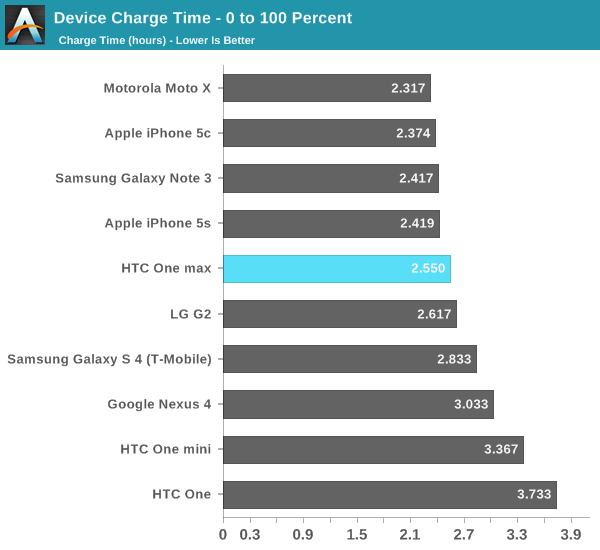
The HTC One charges a bit faster with the latest updates, however the linear region of the charge curve is entirely dominated by that 1 A charging maximum. With the 1.5 A charging in the One max we actually see considerably faster charge times in spite of the larger battery. HTC continues to use BC 1.2 to the best of my knowledge for signaling.
To assess battery life, I ran the One max through our battery life test suite. Our battery life test is unchanged, we calibrate the display to exactly 200 nits and run it through a controlled workload consisting of a dozen or so popular pages and articles with pauses in between continually, until the device dies. This is repeated on cellular and WiFi, in this case since we have an international model of the One max that lacks the LTE bands used in the USA, that’s 3G WCDMA on AT&T’s Band 2 network. The talk time call test is self explanatory and also unchanged.
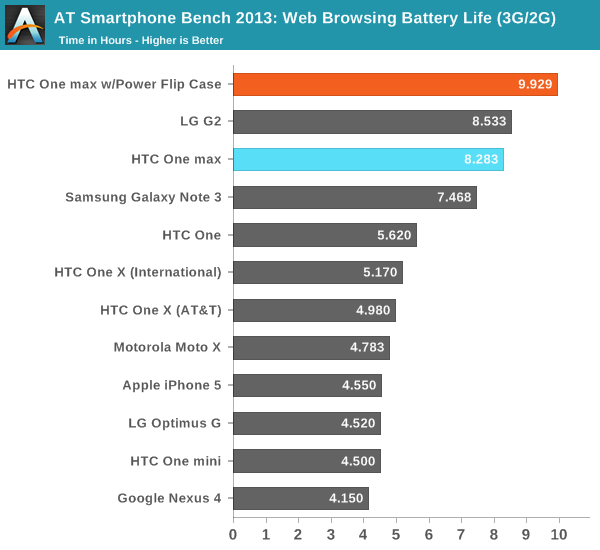
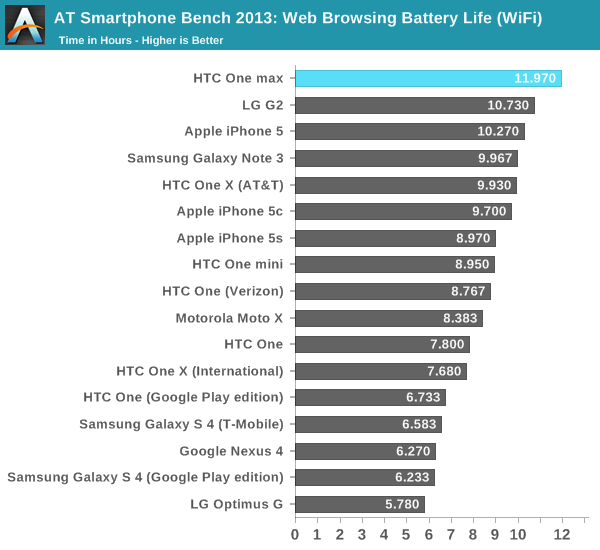
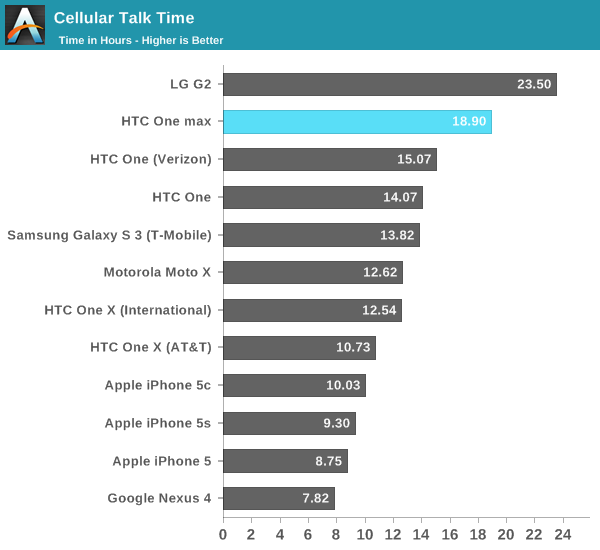
The results speak for themselves, the One max lasts quite a long time on battery, even with a large display. I expected the One max to lose to the Note 3 on the cellular test initially, but it posts an impressive result. I suspect display power might be the reason here between AMOLED and the more pragmatic LCD in the One max. I measured the One max with the flip case on as well, and it adds about 20 percent more battery time to the device. I'm curious to see how the USA-bound variants with LTE fare, but the One does impress with excellent battery life.


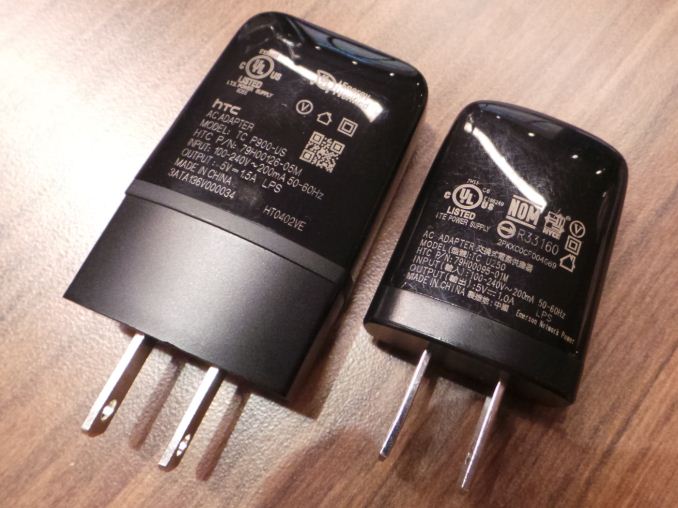








197 Comments
View All Comments
BlakKW - Monday, October 28, 2013 - link
+2cbrownx88 - Monday, October 28, 2013 - link
+3MarcSP - Monday, October 28, 2013 - link
+4hrrmph - Tuesday, October 29, 2013 - link
+5The Saint - Monday, October 28, 2013 - link
"I’ve said my part already on microSD cards and the fact that they’re going the way of the dodo in smartphones, I just don’t need one anymore, and definitely not at the expense of build quality. It is convenient not having to use a SIM ejector tool though, even if I carry one around all the time anyways. For the incredibly small percentage of users that clamors for an SD card every single smartphone launch, it’s at least one point which won’t be belabored so tiresomely this time."That's funny. Seems to me if there's one thing that seems to be going the way of the dodo, it's Android manufacturers like HTC who think prettiness and premium feel are more important than functionality. It will be nice once they go out of business to be able to stop hearing from that tiresome segment of pretend geeks who treat their cellphones like how divas treat their purses - as fashion accessories.
Meanwhile, Samsung will continue laughing by being both the only player that focuses on functionality, and the only player that makes money in the Android world.
nerd1 - Monday, October 28, 2013 - link
Apple charges $100 for 16GB memory and you can find 32GB micro SD at around $15. I wonder why most reviewers conveniently ignore this fact and just compare the baseline price of the products. I can do the math and I won't buy any device without expandability.Drumsticks - Monday, October 28, 2013 - link
I'm not sure that expandibility is the biggest selling point for galaxy phones outside of tech enthusiasts. Most people are not movie hogs etc and find 32GB reasonable. Business users and media enthusiasts on the other hand, would. But they don't represent everyone. Especially with streaming.I think its more brand name appeal and how much more recognizable they are. After all, apple does even better, and its not like they've ever offered MicroSD support.
personally I just think 16GB needs to die, and 32 should be standard up to 128GB in $50 increments max using high quality flash.
Spunjji - Monday, October 28, 2013 - link
Agreed about 16GB needing to die. But why would it when plenty of companies still make an extra $100 per sale by forcing people to upgrade to the minimum serviceable level? At least the Micro SD slot, with all its failings, allows some sort of other option. "pay as you grow" instead of throwing the whole shebang away when your storage needs outpace the crappy little chip soldered into your device.The0ne - Monday, October 28, 2013 - link
My decision on a phone is1. Screen size and resolution
2. MicroSD slot
I use my phone more as a e-reader and media device than a phone. That's not to say I don't use it as a phone normall, I do but it's not all that it does. Duh? Having the MicroSD slot for expansion is Godsend. All my books and technical PDF's are there. All my music, videos and photos are there (just the favorite ones), and so forth.
Why wouldn't you want to have all of those on your phone? It is convenience for me. One device to do what I like to use it for.
Davidjan - Tuesday, October 29, 2013 - link
Agree with you. We can use OTG reader to expand storage like Meenova MicroSD Reader if we want: http://goo.gl/U6IyY